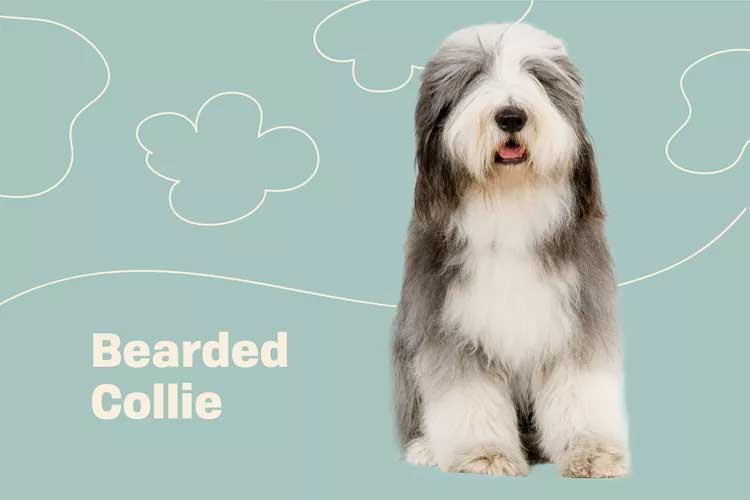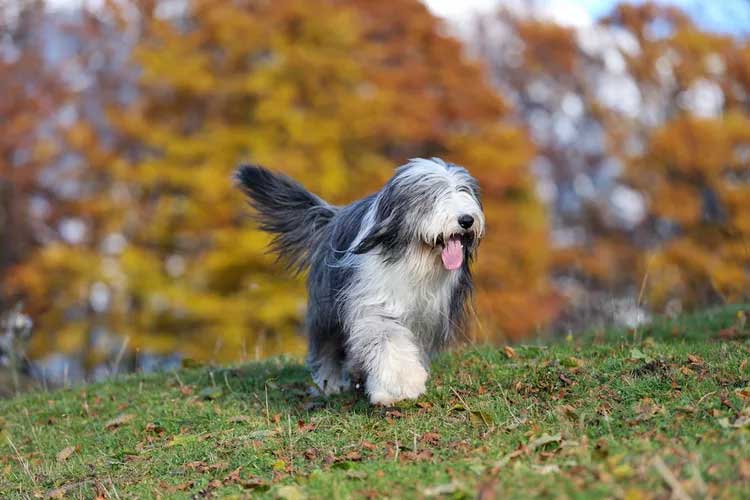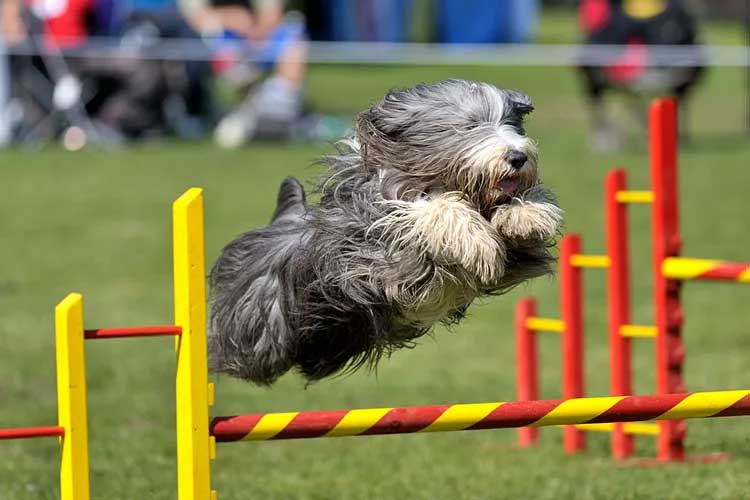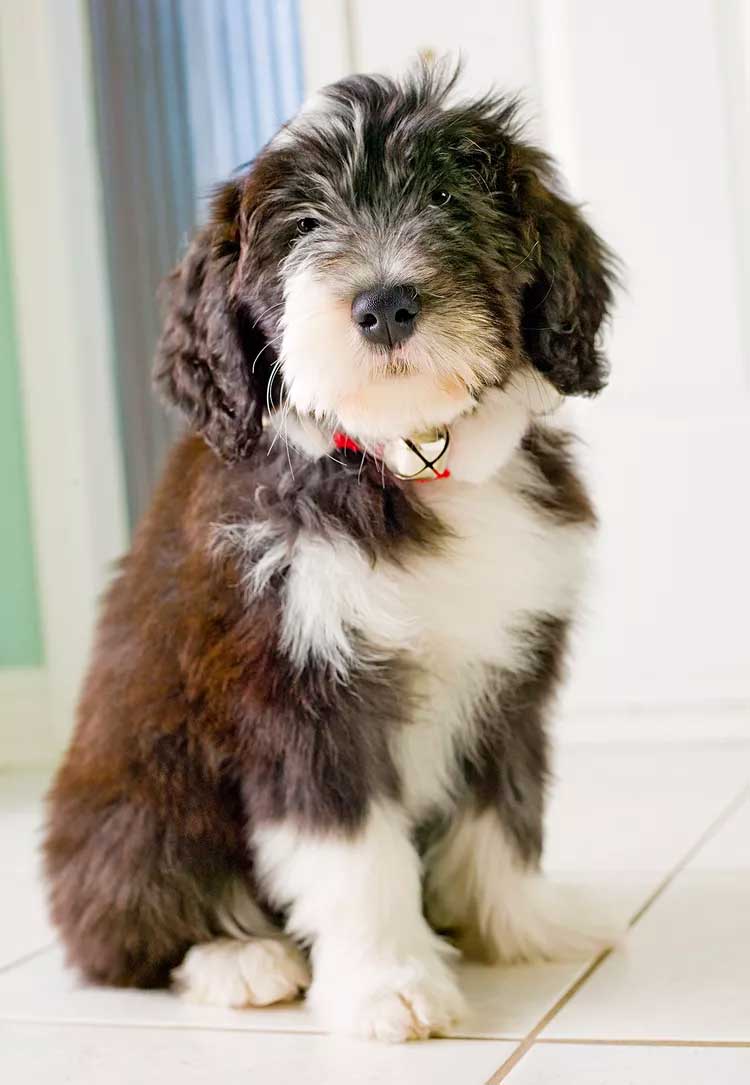Bearded collies are active and friendly. The herding breed excels on the farm, but families love the long-haired dogs thanks to their affectionate natures, playful personalities, and easygoing attitude.

Bearded Collie Overview
| OFFICIAL NAME | Bearded Collie |
| COMMON NAME | Bearded Collie |
| PET HEIGHT | 20 to 22 inches |
| PET WEIGHT | 45 to 55 pounds |
| LIFESPAN | 12 to 14 years |
| GOOD WITH | cats, children, dogs, families |
| TEMPERAMENT | friendly, gentle, outgoing, playful |
| INTELLIGENCE | high |
| SHEDDING AMOUNT | normal |
| EXERCISE NEEDS | high |
| ENERGY LEVEL | active |
| VOCAL LEVEL | frequent |
| DROOL AMOUNT | low |
| BREED GROUP | herding |
| BREED SIZE | medium (26-60 lbs.) |
| COAT LENGTH | long |
| COLORS | black, blue, brown / chocolate / liver, fawn |
| PATTERNS | bicolor |
| OTHER TRAITS | easy to train, good hiking companion, requires lots of grooming |
With his long beard and sweet eyes, it's easy to fall for a bearded collie. Affectionately called a "beardie" by those who love him, he's a hardworking, charming Scotsman with a signature warm coat that turns a lot of heads—and requires a fastidious grooming routine.
The bearded collie is an active breed that needs lots of exercise and thrives in families that provide tons of social interaction and high-energy activities. These dogs do well with children and other pets and are known for being outgoing, affectionate, and playful.
Appearance
Bearded collies have a double coat. Their undercoat is soft with an outercoat of flat, harsh, long hair that gives beardies their signature "shaggy dog" appearance. The hair is longer on their cheeks and under their chins, forming the signature beard that earned bearded collies their name.
Their coats come in four colors: Black, blue, brown, or fawn, and they often have white markings. Their pigmentation matches their coats; black beardies have black eye rims, noses, and lips, while the pigmentation in blue beardies is a blue-grey color and brown bearded collies have brown eye rims, noses, and lips.
Beardies are medium-sized dogs that stand up to 22 inches tall and weigh up to 55 pounds. They have large eyes that hint at their affectionate and soft disposition, and their long, furry tail is always wagging.
Bearded collies are often mistaken for Old English sheepdogs thanks to their similarities in coat and coloring. But there are some ways you can tell a bearded collie vs. Old English sheepdog apart. Old English sheepdogs are much larger than bearded collies—capable of reaching 100 pounds—and have bobbed tails.
Temperament
Like other herding dog breeds, beardies appreciate having a job. These dogs excel in the field and continue to be a favorite farmhand in Scotland—but that doesn't mean bearded collies are all work and no play.As companions, beardies are affectionate, sweet-natured, and social. They've never met a stranger, which is good news because their unique look attracts a lot of attention!
"The breed is friendly, charismatic, affectionate, and independent," says Jerry Klein, DVM, chief veterinary officer for the American Kennel Club (AKC).

Their exuberant personalities make them excellent companions for active, social owners. There is one caveat: This is an active breed that needs a lot of exercise and mental stimulation. Without it, beardies can become bored and anxious. Thankfully, bearded collies are intelligent, eager to learn new things, and easy to train. And, after a high-octane training session or active play, these four-legged family members love to snuggle.
Living Needs
Herding dogs are happiest with room to roam, which means they need a home with a fenced backyard and/or regular walks and trips to the dog park to burn off their boundless energy. A tired beardie is a happy beardie.
The breed is highly adaptable and will easily adjust to almost any family, as long as he gets his exercise. But thanks to their tendency to bark, beardies might not be the best breed for apartment living.
"A well-socialized bearded collie does well in a family with other dogs and children," Klein says.
And if bearded collie puppies are socialized with cats at an early age, the two can live together happily (though, his herding instincts might make your beardie tempted to try rounding up the other family pets).
Bearded collies were bred to be independent workers that managed entire flocks on their own, so spending a few hours alone while their pet parents are at work is no big deal—as long as these active, outgoing dogs get lots of interaction and exercise during other times of the day.
Care
When it comes to keeping your bearded collie happy and healthy, exercise and grooming top the list of must-haves.These are dogs that love to go, go, go. Expect to spend at least an hour every day helping your beardie burn off some energy. Their combination of intelligence and natural athleticism help bearded collies excel in agility, rally, competitive obedience, herding trials, and other dog sports where they can get their paws moving.
"Bearded collies do well with regular exercise either through long walks, hikes, playing ball, or playing in the backyard," Klein says.
It's just as important to engage their minds as their bodies. Bearded collies have big brains and require regular mental stimulation—think interactive toys, puzzles, and games such as hide and seek—to keep their minds engaged.

Keeping him groomed is just as important as exercise. Klein calls grooming a bearded collie a "two-step process" that includes daily brushing to remove dirt and tangles and to prevent their long hair from developing painful mats. The second step, he explains, "is a deep brushing once a week to remove any dead hair." Using a pink rake and detangling spray can help beardies looking their best. Occasional baths can remove excess dirt and oil, too.
Along with their bushy double coat, beardie parents need to pay attention to other parts of their pups, too. Like other breeds, bearded collies need regular dental care that includes at-home teeth brushing and professional cleaning. Klein says that "trimming their nails is just as important because overgrown nails can cause pain while walking."
Like all dogs, bearded collies respond best to consistent positive reinforcement training. To keep him from getting bored, you have to make training fun. Games and fast-paced activities can help keep your beardie's mind engaged while teaching essential skills and new tricks. Again, beardies have an independent streak, so patience is important; positive, rewards-based training using treats and praise can encourage them to stick with training sessions.
Health
Beardies have a lifespan between 12–14 years, and Klein notes that responsible bearded collie breeders should screen their dogs for common health issues that affect the breed. This includes:Hip dysplasia: This condition is diagnosed when the hip joint and socket don't fit together and, instead of smooth movements, the joints grind, causing pain. If left untreated, hip dysplasia can cause osteoarthritis.
Autoimmune thyroiditis: The most common cause of hypothyroidism, autoimmune thyroiditis causes the immune system to attack the thyroid gland. The symptoms include fatigue, lethargy, increased shedding, cold intolerance, and weight gain. A blood test can diagnose the pup.
Cancer: Bearded collies are prone to cutaneous fibrosarcoma, malignant tumors in the soft tissue. The tumors often appear as single lumps or bumps under the skin and can cause symptoms like swelling, pain, lameness, and loss of appetite.
The Bearded Collie Foundation for Health also recommends eye exams for the breed.
History
Bearded collies, also known as Highland collies and Mountain collies, originated in Scotland, where their boundless energy and herding skills earned them top spots on cattle ranches, according to the Bearded Collie Club of America (BCCA). Ranchers depended on their beardies to work cattle and sheep in the pasture and drive herds to market, working long hours on rough terrain and in all kinds of weather.
Although beardies were a common sight on farms across Europe—and are believed to be descendants of European breeds including the komondor and Polish Lowland sheepdogs—upper classes also owned the breed.
The beardie population dwindled after World War I. European breeders worked hard to maintain the breed, keeping it from disappearing—but bearded collies remain rare today. In fact, the first litter of bearded collies wasn't recorded in the United States until 1967. The AKC recognized the breed a decade later in 1976.
Fun Facts
Hollywood loves bearded collies. The breed was featured in films including Mary Poppins, The Absent-Minded Professor, and the 2006 The Shaggy Dog remake. Tiger, the dog who starred in "The Brady Bunch," was also a beardie.In 2017, a bearded collie named Ellee won Best in Show at the AKC National Owner-Handled Series dog show.